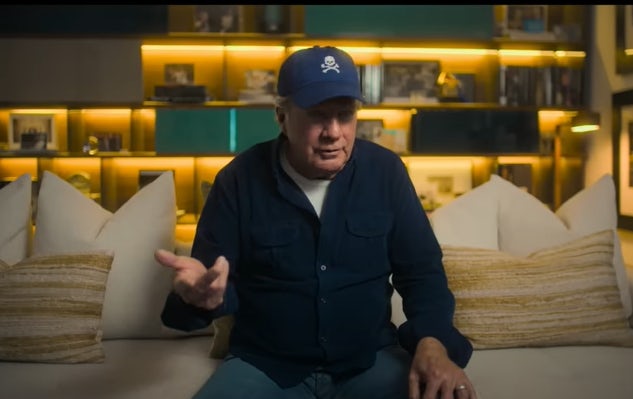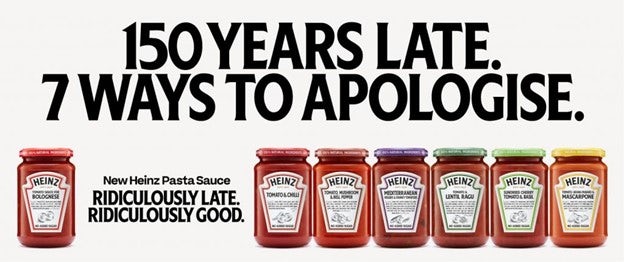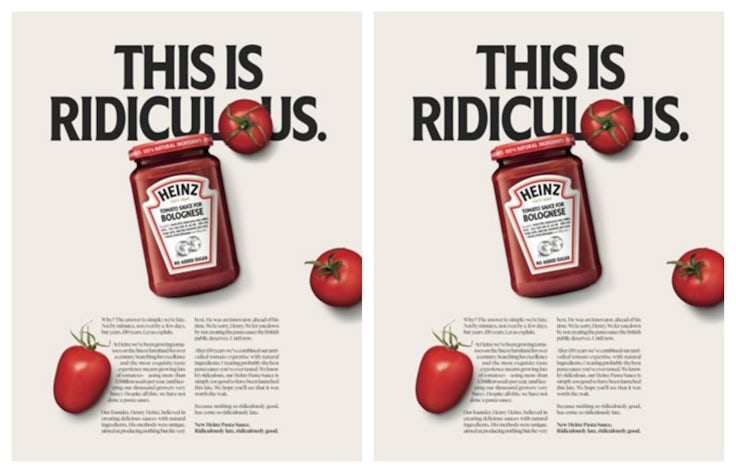Follow Shania Twain’s lead and make sure product isn’t the forgotten P of marketing
Our marketing columnist experiences an epiphany on his couch that leads him to revise his opinion of Heinz pasta sauce and the state of modern marketing.

You know when you see something and brew on it for weeks, sometimes months? That’s been my experience with Heinz and its new range of pasta sauces. Several months back I saw the first advertising for its new range of tomato-based sauces. And I have been mulling it over ever since.
It’s hard to say whether its new products are line extensions or brand extensions. A line extension is a new product in an existing category (like Tag Heuer making a digital watch) and we know from decades of data that these kinds of products are easier to manufacture, more likely to succeed but more damaging to the core existing products should they fail. A brand extension (like Tag Heuer making a mobile phone) is a new product in a category new to the brand. We know these kinds of products are harder to make, less likely to succeed but also much less externally damaging to the existing core range if they don’t work out.
The distinction between line extension and brand extension is usually missed. Which is a shame because the implications of the distinction are significant. More than once, for example, I’ve seen a client opt for a line extension because it’s a “safer” option despite the opposite actually being the case. To be fair, the distinction between line and brand extension is often difficult to discern. When does an existing category end and a new one begin? The demarcation is often grey and relative. In the case of Heinz pasta sauce I would argue the new products are, just, a brand extension. That most consumers will see pouring Heinz sauce onto their pasta as a new thing. But it’s contestable.
Heinz switches slogan to ‘Beanz Meanz More’ as part of purpose drive
That don’t impress me much
But whether it’s a line extension or a brand extension, the product line has surely been hurt by its launch strategy. Heinz, and the team at Wunderman Thompson in Spain that helped develop the line, deserve credit for the way they have attempted to innovate and use their existing core brand to facilitate that innovation rather than create a new unneeded, distracting brand for the Heinz portfolio.
Extending the Heinz brand ensures the new product can lean on a century of trust and quality along with a rich array of distinctive assets that instantly come to mind for the target customer. Retail customers are far more likely to stock the new product given its existing brand status too. And should this new line work out it will bolster the existing Heinz portfolio in synchronous ways that will pay off for years to come. All good stuff. But the launch campaign for the product just sucks so bad I cannot get over it.
It is interesting copy and attention grabbing. But positioning a new product on the fact that “we should have done this ages ago” is stupid and smacks of a total lack of market orientation.
I’m sure that inside Heinz and its agency the fact the company had never launched a pasta sauce is an amazing omission. But not a single target customer has ever thought about this. Nor is it any reason for them to buy the product now that it has been launched “150 years late”. Heinz should stop talking about its internal processes and focus instead on what the sauce does for the target consumer and her pasta.
One of the inalienable models of marketing is the 3Cs of positioning. Sure, a small group of marketing pedants will argue you need extra Cs or a few Ts or whatever, but as usual ignore them and follow canon.
You position any product on what it can do (company C), better or different than the alternatives (competitor C) that the target really cares about (customer C). Find something, anything, that survives these three tests and you are a long way toward marketing success. Miss on any one of the three and your product is unlikely to prosper.
Positioning a new product on the fact that “we should have done this ages ago” is stupid and smacks of a total lack of market orientation.
Often you will see a brand position on what customers want while ignoring the fact that competitors already do it better or your company simply cannot deliver on the claim. It’s much rarer, however, to encounter a case like Heinz in which the positioning focuses exclusively on the company C and completely ignores both customer and competitor. It’s a strangely self-absorbed, indolent way to launch a new product. Like arriving late for a dinner party and berating the guests for starting without you.
I’ve had this discussion before. I remember working for a business school that wanted to spend all its ad budget boasting that it was now rated the top business school in the country. I tried several times to point out that most potential MBA students would still want to know what that meant for them. I remember 3M spending a fortune promoting its products as “made with 3M Innovation” without ever bothering to explain what that did for the customers in question.
As Ted Levitt famously reminds us, it’s about the hole not the drill. Positioning is not about the brand, it’s about the benefits the brand dispenses upon its buyer. That means going further than just features. That means you need to stop talking about yourself in your advertising to some degree. That means changing a brand’s position if it targets different segments who want different things. And that means not focusing on a century long delay in launching a pasta sauce at the expense of describing what it does to someone’s pasta/stomach/family/budget.
Ritson: Attempts to update the four Ps are embarrassing – they’ve endured for a reason
Come on over
I would end it there, except something happened that changed my mind about Heinz pasta sauces. And to explain I have to take you back to earlier this summer and a very special evening.
For some reason on a warm Wednesday night all the stars in the Ritson family aligned. My wife was tired and wanted to go to bed early. My daughter had been to gymnastics and was also in bed, out cold. Both dogs had been on the beach and were comatose at my feet. The rabbits were cuddled up in their hutch with plenty of food. The dishwasher was full and working. The laundry was done.
At 7.25pm I found myself with precisely nothing to do for the first time since 2016.
Surprise is not the same as unprepared, however. Two very, very good reds had been stood to attention in my pantry waiting to serve me for years. Years! Both were now within reach. With cat-like dexterity it took less than a minute from realisation to being sat on the sofa with my two young Spanish friends open in front of me.
At some point over the next salubrious hour I became both drunk and slightly bored. There are only so many times you can rub your hands with glee, take a long loving swig of Rioja and then whimper with the joy of it all. So I turned to Netflix and, for reasons obvious to anyone on a red wine journey, found myself engrossed in the Shania Twain documentary ‘Not Just a Girl’. The programme told the story of Shania’s rise to glory in the 1990s and ruminated on what made her such a stunning success. How had this amazing woman done it? Was it her upbringing? The tragic loss of her parents? Her daring visual risk taking? Her symbiotic relationship with Robert John “Mutt” Lange? The prerogative to have a little fun?
After two bottles of red wine it was like Shakespeare crossed with Agatha Christie. How could we explain the phenomenon that was Shania? How? And then, mid-way through the documentary, Shania’s record label boss turned up and nailed it in 10 seconds. Luke Lewis was sitting in what appeared to be one of the most luxurious offices on the planet wearing a blue baseball cap and the look of a man who knows how things work.

He referred back to Shania’s 40 million selling album, Come On Over, and then explained everything with a wry smile. “I don’t know there are that many albums that have that many hit songs on them,” he explained. “I am pretty sure we charted 12 singles. That’s a lot of great songs on one album. That’s a great deal if you’re a consumer. A really great deal.” He smiled and stared straight down the barrel of the camera with the disarming but unequivocal look of a modern-day Solomon.
You’re still the one
That last bit was probably the red wine. But Luke Lewis taught me something that night. I woke up (still on the sofa) still thinking about it the next day. Most marketers are a bit like that Shania documentary. We look at all these random ephemeral factors and use them to try and predict and then explain marketing success. We obsess over ad creative, effectiveness, budgets, long, short, digital media, traditional media… and we miss the central point that is bigger than all of them. The reason most products work is because they are good. Better than their alternatives. On the things that matter to the target consumers.
The reason Shania became so successful was because her songs were better than anyone else’s. All the rest of it – the back story, the touring strategy, the hundred other reasons purported during the Not Just a Girl documentary are minor factors at best.
The product is the most important P. Explain this to your parents and they will nod their head and question why you would think any differently. The reason you underestimate the power of product is because you are a marketer and know less than your mum and dad about real marketing. You’ve become encapsulated in a world in which marketing is 90% the promotional P with an occasional side reference to distribution and price. The product is no longer part of the marketing remit.
I was struck by that thought last week when I read a post by a very good CEO who mentors a lot of very lucky marketers. “It’s not the best product or service that wins in market,” he posted, “it’s the best marketing that wins, with a business that’s good enough to deliver on your promises.”
And as much as I respect the executive in question, I think his post is doubly wrong. First, because it is the best product or service that wins in the market. Second, because if you understand proper marketing you would instantly spot the tautological error in his post. Marketing includes product development in its approach, so the best marketing and the best product are not adversarial alternatives, they are one and the same. Product is part of marketing. Marketing is part of product. At least it is when you do it properly.
When I pointed this out his reply was that most of the clients he meets already have an existing product. True. But that goes for 99% of all marketing efforts. Kotler might describe a beautiful world in which we find an unserved segment of the market and then we make a product, but the reality is rarely that.
That should not stop marketers from taking an existing product and using their expertise to augment, adjust and improve products and services over time. There is no more important use for market research than the tweaks we make to the product itself.
Marketing is being limited to a promotional discipline. Partly because most marketers lack the disciplinary chops to work back to strategic planning before they execute. And partly because they have allowed one of the most cowing limitations of bad marketing – its inactivity in relation to product – to become a self-fulfilling prophecy. Marketing is more important than product they say, because they have forgotten what marketing was always meant to be.
Kraft Heinz: Our goal is to become global leaders in marketing
From this moment on
I found myself in Tesco a few weeks ago staring at Heinz Tomato Sauce for Bolognese. I’d been thinking about its shit slogan for a month. But, as we all know, salience still works its magic on the reptile brain. And I could not resist looking at it, putting it into my basket and then – when I got home – dumping it all over my tagliatelle.
And you know what? I have to report that it was very good. Very, very good. It actually tasted of tomatoes. It was less gluey than the usual jars of sauce I buy. And it was a lot easier than making a Bolognese from scratch. So I ate all of it. Then sat back and thought about Heinz. About Shania. And about marketing.
Its crap launch won’t do it any favours. But as marketers we must acknowledge the other much greater factors that drive the success or failure of Heinz pasta sauce. Its advertising will play a role. But the fact that it was in Tesco. That it was only two quid. And that it is a pretty good pasta sauce all play a much bigger role in its long-term prospects.
You can see these other more crucial success factors as a reduction in the potential of marketing to make a difference. Or you can throw off the superficial obsession with communications that social media and underwhelming marketers have burdened you with and adopt a more fundamental, accurate, impactful approach to marketing. One in which advertising is 8% of your approach and no more. One in which you accept that a pre-existing product does not pre-empt the potential for marketing to make it better and more successful.
Marketers, behold the product P! Love it from this moment on. It will serve you well. I promise you this.
Mark Ritson teaches how to love product development as part of proper marketing on his award-winning Mini MBA in Marketing. The next course starts in April 2023.









